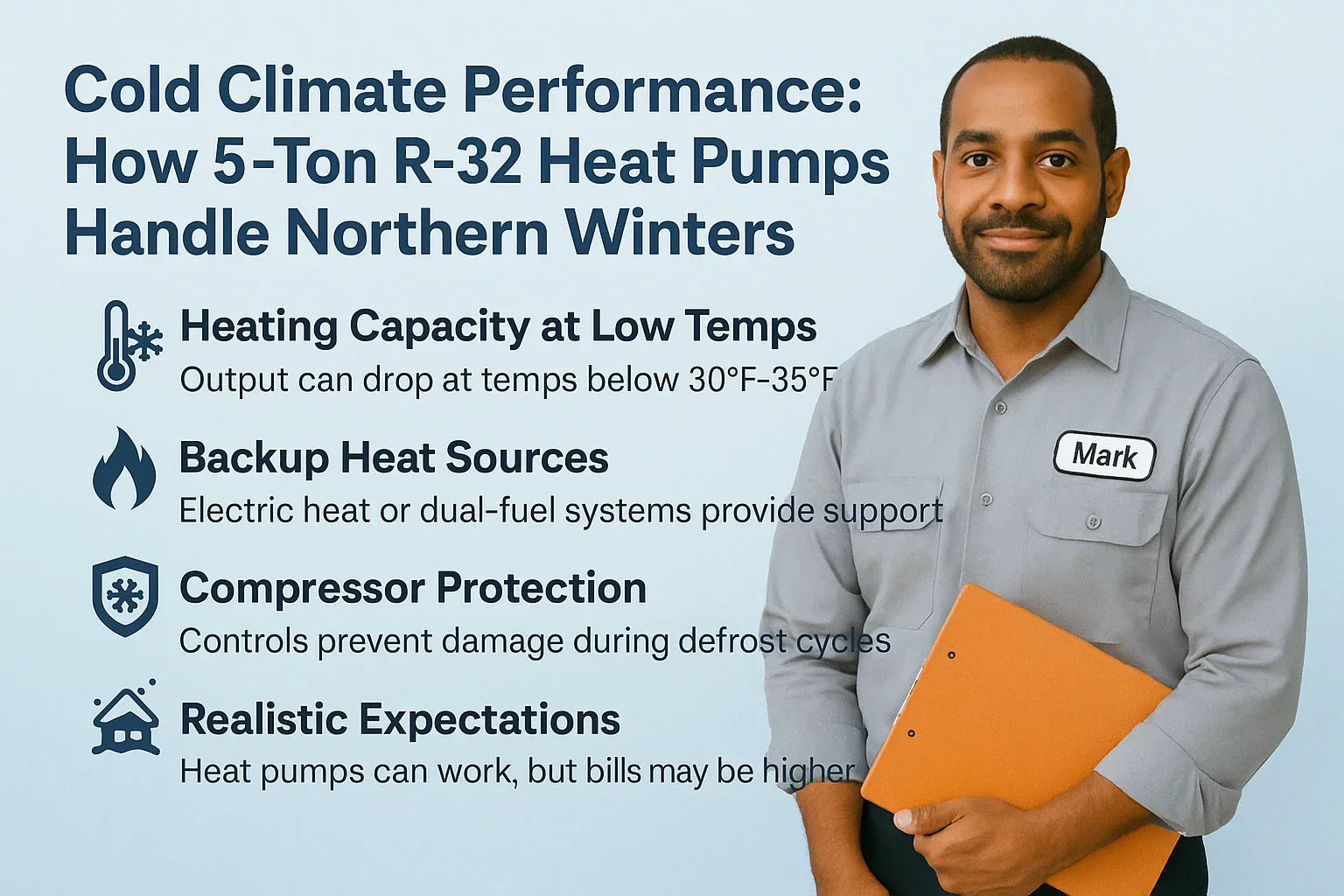Homeowners in cold climates often wonder if a 5-ton R-32 heat pump can efficiently heat their homes during frigid winters. The good news is modern R-32 heat pumps are engineered to perform in low temperatures while delivering efficient, environmentally friendly heating.
This guide explains how 5-ton R-32 heat pumps handle northern winters, including capacity retention, backup heat strategies, and practical planning for your home.
🌀 Understanding How Heat Pumps Work in Winter
Heat pumps extract heat from outdoor air, even in cold weather, and transfer it indoors. Modern inverter-driven R-32 heat pumps can: ✅ Operate efficiently down to 5°F (-15°C).
✅ Continue functioning below 0°F with reduced capacity.
✅ Provide heating at 200–300% efficiency compared to resistance heating.
External Resource: Energy Star: Heat Pumps in Cold Climates
⚡ Advantages of R-32 in Cold Climates
R-32 offers benefits for cold climate operation:
-
Higher heat transfer efficiency for better low-temp performance.
-
Lower Global Warming Potential (GWP) than R-410A.
-
Requires 20–30% less refrigerant, reducing environmental impact.
-
Supports inverter technology for variable-speed operation.
External Resource: Daikin: R-32 Refrigerant
🌡️ Capacity Retention in Cold Weather
All heat pumps lose capacity as outdoor temperatures drop. A quality 5-ton R-32 heat pump will typically:
-
Retain 70–80% of its rated heating capacity at 17°F (-8°C).
-
Retain 50–60% capacity at 5°F (-15°C).
-
Switch to auxiliary heat if temperatures fall below design limits.
External Resource: Energy.gov: Heat Pump Basics
🔥 Backup Heat Strategies
In cold climates, backup heat sources are essential for extreme cold:
-
Electric resistance heat: Built into the air handler, kicks in automatically.
-
Dual-fuel setups: Pairing with a gas furnace for backup heating.
-
Smart thermostat integration: To switch seamlessly based on outdoor temperatures.
These strategies ensure your home remains comfortable during severe cold snaps.
External Resource: Carrier: Heat Pump vs. Furnace
🛠️ Installation Considerations for Cold Climates
For best cold climate performance: ✅ Install in a location protected from wind chill.
✅ Elevate the outdoor unit to prevent snow accumulation.
✅ Ensure proper drainage for defrost cycles.
✅ Use a cold-climate-rated heat pump with enhanced vapor injection (EVI) or low-temp capacity.
External Resource: HVAC.com: Heat Pump Installation in Cold Climates
🔄 Defrost Cycles Explained
In freezing temperatures, frost may accumulate on the outdoor coil. Your heat pump will periodically switch to defrost mode to melt this frost.
-
Duration: 5–15 minutes per cycle.
-
Frequency: Every 30–90 minutes during freezing conditions.
-
During defrost, auxiliary heat maintains indoor comfort.
This is normal and ensures efficient heating during winter.
External Resource: Energy.gov: Heat Pump Defrost Cycles
💡 Energy Efficiency in Winter
Heat pumps remain more energy efficient than electric resistance heating even in cold weather:
-
At 30°F: ~250–300% efficiency.
-
At 17°F: ~200–250% efficiency.
-
Below 5°F: May rely on backup heat, reducing efficiency but maintaining comfort.
Proper system sizing and insulation improvements further enhance efficiency.
External Resource: Energy Star: Cold Climate Heat Pump Guide
🏠 Real-World Case Study: 5-Ton R-32 Heat Pump in a Northern Home
Home: 3,000 sq ft Vermont home with high insulation.
System: 5-ton R-32 inverter-driven heat pump.
Winter Performance:
-
Retained 75% heating capacity at 17°F.
-
Switched to auxiliary heat at -5°F.
-
Reduced heating bills by 35% compared to oil heat.
-
Maintained indoor comfort without noticeable temperature swings.
✅ Conclusion: Is a 5-Ton R-32 Heat Pump Right for Cold Climates?
✅ Modern 5-ton R-32 heat pumps can effectively heat homes in northern climates.
✅ They deliver high efficiency while reducing environmental impact.
✅ Backup heat strategies ensure reliable comfort during extreme cold.
✅ Proper installation is key for peak performance.
If you are in a cold climate looking to reduce your heating bills and carbon footprint, a 5-ton R-32 heat pump is a strong, future-proof option.
In the next topic we will know more about: Energy Efficiency and Tax Credits: Do 5-Ton R-32 AC Units Qualify?







